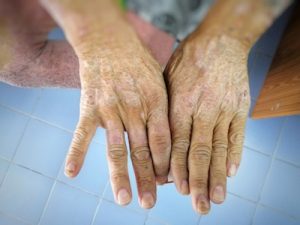Though the medical condition known as scleroderma may worsen with age, the physical manifestations of the malady can be managed. There are even potential treatment options that can help individuals that are stricken with this disease.
Scleroderma Overview
Typically impacting roughly 200,000 Americans per year, this rare autoimmune disorder impacts skin and connective tissue. As the disorder progresses, these bodily structures progressively become harder, which result in numerous untoward, potentially serious symptoms. Usually, the disorder strikes women between ages 30 and 50 and, although the ailment can be hereditary, some afflicted individuals have no prior family history. Furthermore, researchers suggest that the disease might be more prevalent among certain Native American tribes and in African American patients.
Additionally, there are two primary categories of the illness – localized and systemic. Individuals diagnosed with the localized differentiation usually experience mild symptoms that only impact the skin. The systemic variation often produces more severe manifestations that could influence numerous internal bodily regions such as the cardiovascular, respiratory, digestive, and urinary tracts.
Causes
Neither scientific researchers nor doctors have been able to pinpoint the exact cause of the illness. However, medical professionals opine that genetic flaws or environmental toxins could be precipitating factors. That said, the disease process is borne out of the body’s excessive production of a substance known as collagen.
Symptoms

Diagnosis
Physicians might need some time to diagnose this condition. The ailment produces symptoms that mimic other autoimmune disorders and is often found only after thorough physical examinations involving numerous diagnostic tests.
Role of Aging in the Condition’s Exacerbation
Aging can play a significant role in the exacerbation of scleroderma-related symptoms. As people age, they often experience natural processes such as skin changes and other health-related issues. Older persons with this systemic variation of the malady could be at greater risk of suffering serious complications.
Managing Scleroderma and Aging
It is important to realize that there is no cure for the disease at the present. However, the disease can be managed. Specific management techniques will depend upon illness type, the condition’s level of progression and the stricken individual’s general health. Remedial efforts might include the following:
- Medications – Depending on the illness’s severity and the bodily regions it is impacting, a doctor might prescribe drugs such as immunosuppressant preparations, calcium channel blockers (which inhibit calcium from forming under the skin and inside blood vessels), high blood pressure medications and low dosages of steroids (designed to prevent muscle wasting and weakness, especially surrounding the heart).
- Lifestyle Changes – The consumption of a healthy diet rich in immune system-boosting nutrients might help keep certain symptoms at bay. In addition, stricken individuals are cautioned to avoid engaging in potentially harmful habits such as smoking and drinking alcohol excessively.
- Limiting Exposure to Stress – Severe instances of physical or emotional stress are believed to trigger potentially serious flares of the malady. Though it may be impossible to avoid every stressor, patients are encouraged to identify and partake in stress-reducing activities like breathing exercises or a relaxing hobby.
- Exercising – Obtaining an adequate amount of physical activity is crucial to ensuring already brittle muscles and tissues do not stiffen to the point of wasting away and threatening a patient’s mobility. For some individuals, physical therapy might be indicated for this purpose.
- Receiving Palliative Care – For those stricken with severe disease manifestations, activities such as breathing, eating or walking could present a major challenge. These patients might need medical assistance to perform those functions.





